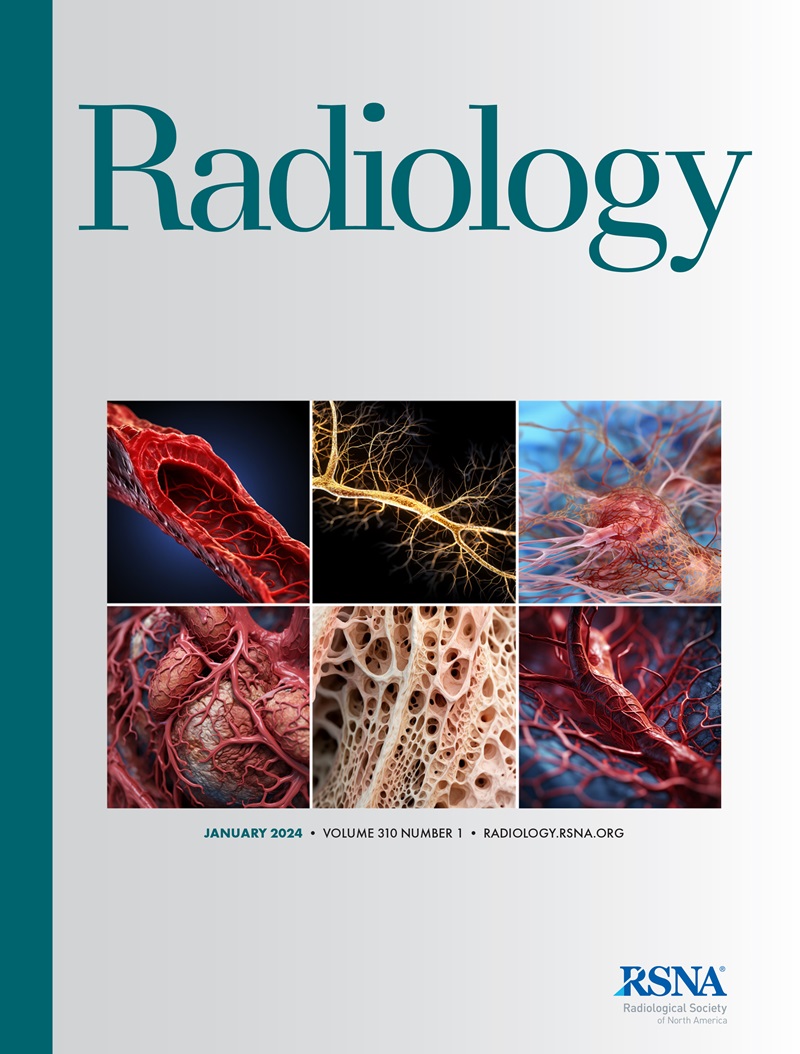求助PDF
{"title":"磁共振成像左心室重塑与长期心血管风险之间的性别特异性关联","authors":"Jonathan R Weir-McCall, Catherine A Fitton, Stephen J Gandy, Matthew Lambert, Roberta Littleford, J Graeme Houston, Jill J F Belch","doi":"10.1148/radiol.232997","DOIUrl":null,"url":null,"abstract":"<p><p>Background Left ventricular mass (LVM) is an established marker of cardiovascular risk; however, long-term follow-up studies in individuals with low to intermediate risk are lacking. Purpose To assess the sex-specific association of LVM measured with cardiac MRI with cardiovascular outcomes in those with a less than 20% 10-year risk of cardiovascular disease (CVD). Materials and Methods A total of 1528 volunteers older than 40 years of age with no history of CVD, a 10-year risk of CVD of less than 20%, and a B-type natriuretic peptide level greater than their sex-specific median underwent cardiac MRI between June 2008 and February 2013 as part of the Tayside Screening for Cardiac Events, or TASCFORCE, prospective study. LVM was indexed to body surface area, and the LVM-to-volume ratio was calculated. Follow-up for cardiovascular events was performed using national electronic health records. Cox proportional hazard models and Kaplan-Meier curves were applied to assess the impact of LVM. Results A total of 1495 participants (mean age, 54.5 years ± 8.3 [SD]; 925 female, 570 male) completed cardiac MRI, with a median follow-up of 10 years (IQR, 3 years). In female participants, LVM was associated with age, blood pressure, smoking status, and cholesterol level, while in male participants, LVM was associated with age and blood pressure. In female participants, the LVM-to-volume ratio was associated with cardiovascular events (hazard ratio [HR], 2.3 [95% CI: 1.1, 4.9] for the highest quartile vs the lowest quartile), while the LVM was not. In male participants, the LVM was associated with cardiovascular events (HR, 3.2 [95% CI: 1.5,7.0] for the highest quartile vs the lowest quartile), while the LVM-to-volume ratio was not. Conclusion In those with low to intermediate risk without established CVD, different remodeling patterns predict cardiovascular events, with increased LVM predictive in male participants, while LVM-to-volume ratio is predictive in female participants. © RSNA, 2024 <i>Supplemental material is available for this article.</i> See also the editorial by Garot and Duhamel in this issue.</p>","PeriodicalId":20896,"journal":{"name":"Radiology","volume":"313 2","pages":"e232997"},"PeriodicalIF":12.1000,"publicationDate":"2024-11-01","publicationTypes":"Journal Article","fieldsOfStudy":null,"isOpenAccess":false,"openAccessPdf":"","citationCount":"0","resultStr":"{\"title\":\"Sex-specific Associations between Left Ventricular Remodeling at MRI and Long-term Cardiovascular Risk.\",\"authors\":\"Jonathan R Weir-McCall, Catherine A Fitton, Stephen J Gandy, Matthew Lambert, Roberta Littleford, J Graeme Houston, Jill J F Belch\",\"doi\":\"10.1148/radiol.232997\",\"DOIUrl\":null,\"url\":null,\"abstract\":\"<p><p>Background Left ventricular mass (LVM) is an established marker of cardiovascular risk; however, long-term follow-up studies in individuals with low to intermediate risk are lacking. Purpose To assess the sex-specific association of LVM measured with cardiac MRI with cardiovascular outcomes in those with a less than 20% 10-year risk of cardiovascular disease (CVD). Materials and Methods A total of 1528 volunteers older than 40 years of age with no history of CVD, a 10-year risk of CVD of less than 20%, and a B-type natriuretic peptide level greater than their sex-specific median underwent cardiac MRI between June 2008 and February 2013 as part of the Tayside Screening for Cardiac Events, or TASCFORCE, prospective study. LVM was indexed to body surface area, and the LVM-to-volume ratio was calculated. Follow-up for cardiovascular events was performed using national electronic health records. Cox proportional hazard models and Kaplan-Meier curves were applied to assess the impact of LVM. Results A total of 1495 participants (mean age, 54.5 years ± 8.3 [SD]; 925 female, 570 male) completed cardiac MRI, with a median follow-up of 10 years (IQR, 3 years). In female participants, LVM was associated with age, blood pressure, smoking status, and cholesterol level, while in male participants, LVM was associated with age and blood pressure. In female participants, the LVM-to-volume ratio was associated with cardiovascular events (hazard ratio [HR], 2.3 [95% CI: 1.1, 4.9] for the highest quartile vs the lowest quartile), while the LVM was not. In male participants, the LVM was associated with cardiovascular events (HR, 3.2 [95% CI: 1.5,7.0] for the highest quartile vs the lowest quartile), while the LVM-to-volume ratio was not. Conclusion In those with low to intermediate risk without established CVD, different remodeling patterns predict cardiovascular events, with increased LVM predictive in male participants, while LVM-to-volume ratio is predictive in female participants. © RSNA, 2024 <i>Supplemental material is available for this article.</i> See also the editorial by Garot and Duhamel in this issue.</p>\",\"PeriodicalId\":20896,\"journal\":{\"name\":\"Radiology\",\"volume\":\"313 2\",\"pages\":\"e232997\"},\"PeriodicalIF\":12.1000,\"publicationDate\":\"2024-11-01\",\"publicationTypes\":\"Journal Article\",\"fieldsOfStudy\":null,\"isOpenAccess\":false,\"openAccessPdf\":\"\",\"citationCount\":\"0\",\"resultStr\":null,\"platform\":\"Semanticscholar\",\"paperid\":null,\"PeriodicalName\":\"Radiology\",\"FirstCategoryId\":\"3\",\"ListUrlMain\":\"https://doi.org/10.1148/radiol.232997\",\"RegionNum\":1,\"RegionCategory\":\"医学\",\"ArticlePicture\":[],\"TitleCN\":null,\"AbstractTextCN\":null,\"PMCID\":null,\"EPubDate\":\"\",\"PubModel\":\"\",\"JCR\":\"Q1\",\"JCRName\":\"RADIOLOGY, NUCLEAR MEDICINE & MEDICAL IMAGING\",\"Score\":null,\"Total\":0}","platform":"Semanticscholar","paperid":null,"PeriodicalName":"Radiology","FirstCategoryId":"3","ListUrlMain":"https://doi.org/10.1148/radiol.232997","RegionNum":1,"RegionCategory":"医学","ArticlePicture":[],"TitleCN":null,"AbstractTextCN":null,"PMCID":null,"EPubDate":"","PubModel":"","JCR":"Q1","JCRName":"RADIOLOGY, NUCLEAR MEDICINE & MEDICAL IMAGING","Score":null,"Total":0}
引用次数: 0
引用
批量引用


